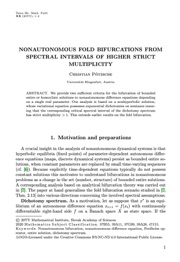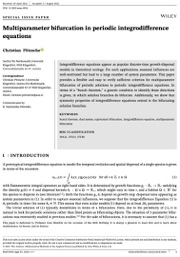Bifurcation and continuation
AAU
Christian Pötzsche (Mar 2023)
Persistence and imperfection in nonautonomous bifurcation patterns
Journal of Differential Equations 250, 2011, 3874-3906
For nonautonomous dynamical systems a bifurcation can be understood as topological change in the set of bounded entire solutions to a given time-dependent evolutionary equation. Following this idea, a Fredholm theory via exponential dichotomies on semiaxes enables us to employ tools from analytical branching theory yielding nonautonomous versions of fold, transcritical and pitchfork patterns. This approach imposes the serious hypothesis that precise quantitative information on the dichotomies is required - an assumption hard to satisfy in applications. Thus, imperfect bifurcations become important.
In this paper, we discuss persistence and changes in the previously mentioned bifurcation scenarios by including an additional perturbation parameter. While the unperturbed case captures the above bifurcation patterns, we obtain their unfolding and therefore the local branching picture in a whole neighborhood of the system. Using an operator formulation of parabolic differential, Carathéodory differential and difference equations, this will be achieved on the basis of recent abstract analytical techniques due to Shi (1999) and Liu, Shi & Wang (2007).
Nonautonomous bifurcation of bounded solutions III: Crossing-curve situations
Stochastics and Dynamics 12(2), 2012
We follow an approach to a bifurcation theory for nonautonomous differential equations based on a change in the structure of bounded complete solutions. In the framework of Carathéodory differential equations, we provide sufficient criteria for such a nonhyperbolic solution to bifurcate into two branches of solutions. This scenario is somewhat typical in the sense that (a) transcritical and pitchfork bifurcations are special cases, but (b) no branch of trivial solutions is supposed to exist. In particular, we discuss a degenerate fold bifurcation pattern, where the transversality assumption is replaced by a nondegeneracy condition on the second order derivative. Both bifurcation patterns are intrinsically nonautonomous and do not occur for time-invariant equations.
Our notion of a nonhyperbolic solution is based on the fact that the associate variational equation possesses exponential dichotomies on both semiaxes with compatible projectors. The resulting Fredholm theory allows to apply recent abstract bifurcation results due to Liu, Shi and Wang (2007).
Nonautonomous bifurcation of bounded solutions I: A Lyapunov-Schmidt approach
Discrete and Continuous Dynamical Systems, Series B, 14(2), 2010,
739-776
We investigate local bifurcation properties for nonautonomous difference and ordinary differential equations. Extending a well-established autonomous theory, due to our arbitrary time dependence, equilibria or periodic solutions typically do not exist and are replaced by bounded complete solutions as possible bifurcating objects. Under this premise, exponential dichotomies in variation provide the necessary Fredholm theory in order to employ a Lyapunov-Schmidt reduction. Among other results, this yields nonautonomous versions of the classical fold, transcritical and pitchfork bifurcation patterns.
Dedicated to Peter E. Kloeden on the occasion of his 60th birthday.
Nonautonomous continuation of bounded solutions
Communications in Pure and Applied Analysis 10(3), 2011, 937-961
We show the persistence of hyperbolic bounded solutions to nonautonomous difference and retarded functional differential equations under parameter perturbation, where hyperbolicity is given in terms of an exponential dichotomy in variation. Our functional-analytical approach is based on a formulation of dynamical systems as operator equations in ambient sequence or function spaces. This yields short proofs, in particular of the stable manifold theorem.
As an ad hoc application, the behavior of hyperbolic solutions and stable manifolds for ODEs under numerical discretization with varying step-sizes is studied.
Robustness of hyperbolic solutions under parametric perturbations
Journal of Difference Equations and Applications 15(8-9), 2009,
803-819
We show that bounded and globally defined hyperbolic solutions of difference equations persist under time-dependent parametric perturbations, which are assumed to be uniformly small, but otherwise arbitrarily bounded. Moreover, we demonstrate that similar robustness results hold in the classes of almost periodic, periodic and limit zero solutions. The proof is based on the idea to convert difference equations into operator equations in corresponding sequence spaces, and the implicit function theorem.
This paper is dedicated to Professor Robert J. Sacker on the occasion of his 70th birthday. His bifurcation turned out to be my first serious encounter with dynamical systems, while the contributions to skew-product flows paved my way to nonautonomous problems.
Awarded “Best paper on difference equations in 2009“ and featured in a special issue of the Journal of Difference Equations and Applications.
Nonautonomous bifurcation of bounded solutions II: A shovel-bifurcation pattern
Discrete and Continuous Dynamical Systems, Series A, 31(3), 2011, 941-973
This paper continues our work on local bifurcations for nonautonomous difference and ordinary differential equations. Here, it is our premise that constant or periodic solutions are replaced by bounded complete solutions as bifurcating objects in order to encounter right-hand sides with an arbitrary time dependence.
We introduce a bifurcation pattern caused by a dominant spectral interval (of the dichotomy spectrum) crossing the stability boundary. As a result, differing from the classical autonomous (or periodic) situation, the change of stability appears in two steps from uniformly asymptotically stable to asymptotically stable finally to unstable. During the asymptotically stable regime, a whole family of bounded complete solutions occurs (a so-called "shovel"). Our basic tools are exponential trichotomies and a quantitative version of the surjective implicit function theorem.
Bifurcations in nonautonomous dynamical systems: Results and tools in discrete time
in Proceedings of the international workshop Future Directions in Difference Equations, June 13-17 2011, Vigo, Spain, 163-212
When extending the qualitative and dynamical theory from autonomous difference equations (mappings) to explicitly time-dependent problems, one is confronted with three intrinsic problems: One needs a more flexible notion of invariance, eigenvalues do not yield meaningful stability information, and generically such equations do not possess equilibria.
In this admittedly biased survey paper, we address the above aspects and discuss several approaches in the development of a corresponding bifurcation theory for nonautonomous difference equations. First, we present a spectral notion based on exponential dichotomies and give continuation results for entire bounded solutions. Second, we discuss so-called solution, as well as attractor bifurcations and illustrate them using various examples. Finally, to apply the above results in higher-dimensional problems, we tackle an applicable version of Pliss’s reduction principle via nonautonomous center manifolds — so-called center fiber bundles.
Bifurcations in a periodic discrete-time environment
Nonlinear Analysis (RWA) 14(1), 2013, 52-83
In a tutorial way, this paper investigates local and global bifurcation, as well as continuation properties for discrete-time periodic dynamical models in arbitrary (finite) dimension. Our focus is to provide explicitly verifiable conditions which guarantee or prevent bifurcations of, say $\omega_1$-periodic solutions for $\omega_0$-periodic difference equations. In doing so, we give concrete branching relations ensuring bifurcations of e.g. fold, transcritical, pitchfork or flip type. Beyond that we provide formulas indicating the local behavior of mean population sizes under parameter variation or bifurcation, and also tackle stability issues.
Global continuation of homoclinic solutions
(with R. Skiba), Zeitschrift für Analysis und ihre Anwendungen 37(2), 2018, 159-187
When extending bifurcation theory of dynamical systems to nonautonomous problems, it is a central observation that hyperbolic equilibria persist as bounded entire solutions under small temporally varying perturbations. In this paper, we abandon the smallness assumption and aim to investigate the global structure of the entity of all such bounded entire solutions in the situation of nonautonomous difference equations. Our tools are global implicit function theorems based on an ambient degree theory due to Fitzpatrick, Pejsachowicz and Rabier. For this we yet have to restrict to so-called homoclinic solutions, whose limit is 0 in both time directions
A continuation principle for Fredholm maps I:
Theory and basics
(with R. Skiba), Mathematische Nachrichten 293(5), 2020, 983-1003
We prove an abstract and flexible continuation theorem for zeros of parametrized Fredholm maps between Banach spaces. It guarantees not only the existence of zeros to corresponding equations, but also that they form a continuum for parameters from a connected manifold. Our basic tools are transfer maps and a specific topological degree. The main result is tailor-made to solve boundary value problems over infinite time-intervals and for the (global) continuation of homoclinic solutions.
A continuation principle for Fredholm maps II:
Application to homoclinic solutions
(with R. Skiba), Mathematische Nachrichten 293(6), 2020, 1174-1199
When studying the behavior of autonomous ordinary differential equations under time-dependent perturbations vanishing for $t\to\pm\infty$, their equilibria generically persist locally as homoclinic solutions. Using an abstract and flexible continuation theorem, we find even global branches of such homoclinic solutions for parametrized nonautonomous ordinary differential equations. Our approach is based on degree-theoretical arguments. In particular, Landesman-Lazer conditions are proposed to obtain the existence of homoclinic solutions by means of a nonzero degree.
(with C. Aarset), Discrete and Continuous Dynamical Systems (Series B) 26(1), 1-60
We study local bifurcations of periodic solutions to time-periodic (systems of) integrodifference equations over compact habitats. Such infinite-dimensional discrete dynamical systems arise in theoretical ecology as models to describe the spatial dispersal of species having nonoverlapping generations. Our explicit criteria allow us to identify branchings of fold- and crossing curve-type, which include the classical transcritical-, pitchfork- and flip-scenario as special cases. Indeed, not only tools to detect qualitative changes in models from e.g. spatial ecology and related simulations are provided, but these critical transitions are also classified. In addition, the bifurcation behavior of various time-periodic integrodifference equations is investigated and illustrated. This requires a combination of analytical methods and numerical tools based on Nyström discretization of the integral operators involved.
Bifurcations in periodic integrodifference equations in C(������) II: Discrete torus bifurcation
(with C. Aarset), Communications in Pure and Applied Analysis 19(4), 2020, 1847-1874
We provide a convenient Neimark-Sacker bifurcation result for time-periodic difference equations in arbitrary Banach spaces. It insures the bifurcation of ``discrete invariant tori’’ caused by a pair of complex-conjugated Floquet multipliers crossing the complex unit circle. This criterion is made explicit for integrodifference equations, which are infinite-dimensional discrete dynamical systems popular in theoretical ecology, and are used do describe the temporal evolution and spatial dispersal of populations with nonoverlapping generations. As an application, we combine analytical and numerical tools for a detailed bifurcation analysis of a spatial predator-prey model. Since such realistic models can frequently only be studied numerically, we formulate our assumptions in such a fashion as to allow for numerically stable verification.
Dedicated to Tomás Caraballo on the occasion of his 60th birthday
Nonautonomous fold bifurcations from spectral intervals of higher strict multiplicity
to appear in Tatra Mountain Mathematical Publications (24p.)
We provide two sufficient criteria for the bifurcation of bounded entire or homoclinic solutions to nonautonomous difference equations depending on a single real parameter. Our analysis is based on a nonhyperbolic solution, whose variational equation possesses exponential dichotomies on semiaxes ensuring that the corresponding critical spectral interval of the dichotomy spectrum has strict multiplicity >1. This extends earlier results on the fold bifurcation.
Multiparameter bifurcations in periodic integrodifference equations
Mathematical Methods in the applied Sciences 2023, 1-17
Integrodifference equations appear as popular discrete-time growth-dispersal models in theoretical ecology. For such applications, seasonal influences are well-motivated but lead to a large number of system parameters. This paper provides a flexible and easy to verify sufficient criterion for multiparameter bifurcation of periodic solutions to periodic integrodifference equations. In terms of a ``bunch theorem’’, a generic condition to identify those directions is given, in which solutions branches do bifurcate. Additionally, we show that symmetry properties of integrodifference equations extend to the bifurcation solution branches.
This paper is dedicated to Professor Jean Mawhin on the occastion of his 80th birthday.














